35 Evergreen Trees for Growing in Shade

Many types of evergreen trees are suitable for growing in shady areas of your garden. Coniferous evergreen trees like hemlocks, yew, and certain spruce trees tolerate varying amounts of shade. Also, several broadleaf tree varieties like boxwoods, wax myrtles, and holly trees grow well without direct sunlight. However, not all evergreen trees are shade-tolerant and thrive in shady landscapes.
Finding evergreen shade trees can be challenging for gardeners. However, planting evergreen shade trees and shrubs is vital to provide beauty and privacy in a backyard. With the right knowledge and careful planning, you can create a lush and inviting space, even in the shadiest corners of your yard.
This article has a comprehensive list of evergreen trees that can thrive in shady conditions. Descriptions and pictures of the shade-loving tree foliage, height, and growth habits will help you choose the best evergreen coniferous and broadleaf trees for your landscape.
What Are Evergreen Trees for Growing in Shade?
Evergreen shade-loving trees maintain their foliage throughout the year. Despite getting fewer than four hours of direct sunlight daily, they provide consistent shelter and privacy. Planting trees for partial or deep shade lets you beautify a shaded front or backyard by creating a lush, shaded year-long environment.
Knowing the different types of shade is essential when choosing evergreen shade trees. Here is a brief explanation of light requirements for shade-loving shrubs and trees:
Dappled shade: Occurs when sunlight filters through overhead foliage, creating a scattered pattern of light and shade on the ground.
Partial shade: Moderate light levels where trees get four to six hours of direct light. Trees for partially shaded conditions typically require protection from intense sunlight from midday until late afternoon.
Full shade: These areas of a yard receive little or no direct sunlight. Typically, full shade is fewer than two hours of direct sunlight daily.
Deep shade: Yard areas with no direct sunlight. Typically, these areas are north-facing landscapes near tall buildings and trees that keep front or backyards in constant shadows.
The Best Evergreen Trees for Growing in Shade
The best evergreen trees for shade include boxwood trees, hemlocks, some yew varieties, and holly trees. These evergreen shrubs and trees thrive in full shade and moist, well-drained soils. Their evergreen foliage contributes to a lush, shaded environment throughout the year. Together, they offer diverse textures and year-round greenery in shaded garden spaces without requiring much care or maintenance.
Evergreen Trees for Growing in Shade — with Pictures and Descriptions
Let’s look in detail at various types of coniferous and deciduous shade trees for your garden landscape.
Broadleaf Evergreen Trees for Growing in Shade
Most broadleaf evergreen trees are suitable for dappled sunlight, light shade, or partial shade. However, a few tree varieties tolerate deep shade. Please read on to find out more.
American Holly (Ilex opaca)

American holly is an evergreen tree that tolerates partial shade or full sun. This broadleaf evergreen is known for its glossy green leaves with spiny edges and bright red berries. The slow-growing tree has a conical to pyramidal shape, and its branches reach the ground.
American holly trees grow 40 to 60 ft. (12 – 18 m) tall and 20 ft. (6 m) wide. Their evergreen foliage, low-branching habit, and dense growth make them ideal as a privacy screen, security barrier, or windbreak. They thrive in full sun to partial shade and well-draining soil. Once established, the tree is drought-tolerant.
The bright red berries provide food for birds during the winter months and add a splash of color to the landscape.
- USDA Growing Zone: 5 to 9
- Mature Tree Size: 40 to 60 ft. (12 – 18 m) tall and 20 ft. (6 m) wide
- Sunlight: Full sun to partial shade (2 to 8 hours of sunlight)
Longstalk Holly (Ilex pedunculosa)

Longstalk holly is a medium-sized, hardy, evergreen tree that can tolerate as little as two hours of sunlight daily. It has glossy green, spineless leaves, clusters of fragrant white flowers, and red winter berries. Not growing taller than 30 ft. (9 m), the evergreen tree is suitable for growing in a compact, shady garden.
Longstalk holly trees handle shady conditions exceptionally well. They prefer moist, well-drained soil and can tolerate a range of soil types. Thriving in partially shaded conditions, they grow well as a privacy screen, evergreen border plant, or hedge. Their red berries attract birds and wildlife in winter.
- USDA Growing Zone: 4 to 8
- Mature Tree Size: 20 to 30 ft. (6 – 9 m) tall and 20 ft. (6 m) wide
- Sunlight: Full sun or partial shade
English Holly (Ilex aquifolium)

English holly is a flowering evergreen pyramid-shaped shade tree popular for its glossy, dark green leaves and bright red berries. The holly trees bloom in spring with clusters of small white flowers that emit a sweet fragrance. Like many holly trees, the evergreen broad leaves are prickly, with wavy margins, measuring up to 3” (7.5 cm) long.
Not growing taller than 50 feet (15 meters), evergreen holly has a dense, pyramidal growth habit. Its tolerance to shade makes it versatile in landscapes such as a foundation planting, a privacy hedge, or a specimen plant. However, it needs well-drained soil to thrive in partial shade.
- USDA Growing Zone: 7 to 9
- Mature Tree Size: 30 to 50 ft. (9 – 15 m) tall and 15 to 25 ft. (4.5 – 7.6 m) wide
- Sunlight: Full sun to partial shade
False Holly (Osmanthus heterophyllus)

False holly is recognized by its upright, oval shape, dark green leaves, and pungently sweet flowers. The small shrub-like evergreen tree rarely grows taller than 10 ft. (3 m) tall. The small tree has glossy, dark green, leathery leaves with jagged margins arranged oppositely on stems. The holly tree also produces round, purplish-black berries.
Though it is not a true holly, it provides a similar aesthetic appeal for shaded, compact front or backyards. It’s easy to maintain and tolerate various soil conditions. Landscaping uses for the false holly tree include security borders, privacy screens, foundation planting, and a garden divider.
- USDA Growing Zone: 7 to 9
- Mature Tree Size: 8 to 10 ft. (2.4 – 3 m) tall and wide–rarely up to 20 ft. (6 m)
- Sunlight: Full sun or partial shade
Tree Boxwood (Buxus sempervirens ‘Arborescens’)

Tree boxwood is a slow-growing evergreen shrub that can grow as a small tree up to 15 ft. (4.5 m) tall. Resistant to shade, the landscaping plant has small, oval, dark green leaves that retain color throughout the year. In heavy shade, the tree’s foliage may become sparser. However, direct sunlight can scorch the leaves.
Tree boxwoods are ideal for creating formal hedges and topiaries or as a focal point in partially shaded gardens. It is a versatile plant that grows well in clay, loamy, and sandy soils if there is good drainage.
- USDA Growing Zone: 5 to 8
- Mature Tree Size: 8 to 15 ft. (2.4 – 4.5 m) tall and 10 ft. (3 m) wide
- Sunlight: Full sun or partial shade
Southern Magnolia (Magnolia grandiflora)

Southern magnolia is a stunning evergreen tree that loves partially shaded conditions. Identifying features of the tree are its creamy-white, cup-shaped blossoms, leathery, oval leaves, and rose-red seeds. Growing over 60 ft. (18 m) tall, the white-flowering magnolia provides shade thanks to its pyramidal or rounded crown.
Southern magnolias are native to the southeastern United States. The spectacular, fragrant flowers bloom in spring and continue throughout the summer. They can measure up to 12” (30 cm) in diameter. In addition to attracting pollinators, the tree’s dense evergreen foliage provides shelter for native birds and small mammals.
Southern magnolias are usually planted as specimen trees in landscapes. Additionally, their beautiful flowers are ideal for romantic floral displays.
- USDA Growing Zone: 7 to 10
- Mature Tree Size: 60 to 80 ft. (18 – 24 m) tall and 30 to 50 ft. (9 – 15 m) wide
- Sunlight: Full sun or partial shade
Strawberry Tree (Arbutus unedo)
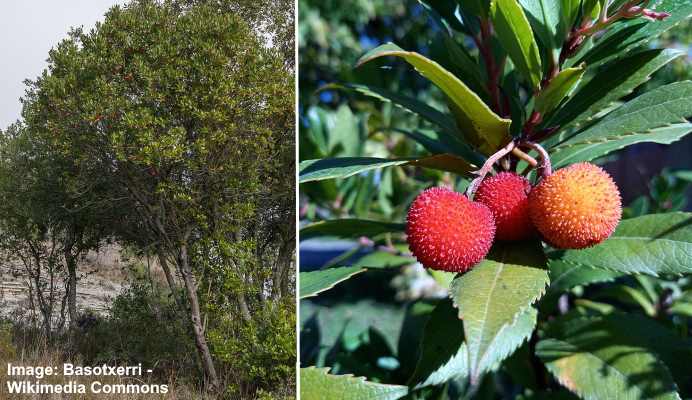
The strawberry tree is a unique evergreen tree with attractive leaves, fruit, and bark. Thriving in partial shade, the small tree has clusters of bell-shaped white flowers blooming throughout fall and winter. Its unusual fruits look like strawberries and taste sweet but sometimes bland. The tree’s grayish bark peels, revealing a cinnamon-colored inner bark.
Aside from its flowers and red fruits, the strawberry tree has tremendous ornamental appeal. The lush green leaves grow on red stems. Its branches become gnarled with age, giving the trees an attractive appearance. Landscaping uses for the small tree include hedges, coastal gardens, shrub borders, and foundation planting.
- USDA Growing Zone: 7 to 10
- Mature Tree Size: 6 to 15 ft. (1.8 – 4.5 m) tall and wide
- Sunlight: Full sun or partial shade
Wheel Tree (Trochodendron aralioides)

Wheel tree is an attractive shrub-like evergreen tree that performs best in afternoon shade. The slow-growing tree has distinctive lanceolate leaves growing in whorls. The evergreen leaves grow 6” (15 cm) long and are dark green with paler undersides. They turn bronze with reddish shading in the fall.
Wheel tree flowers are clusters of green, yellow, or purple showy, star-shaped blooms. The erect cymes grow up to 5” (13 cm) tall, each containing up to 20 flowers. Due to its shade tolerance, wheel trees are ideal understory trees or specimen plants in shady spots.
- USDA Growing Zone: 6 to 8
- Mature Tree Size: 10 to 20 ft. (3 – 6 m) tall and up to 15 ft. (4.5 m) wide
- Sunlight: Partial shade or dappled sunlight
Southern Wax Myrtle (Morella cerifera)

Southern wax myrtle is a versatile evergreen small tree that performs well in dry shade or light shade. Growing around 20 ft. (6 m) tall, the native tree is identified by its narrow, olive-green leaves, dangling clusters of golden yellow flowers, and small globose bluish fruits covered in a waxy substance.
Wax myrtle plants have dense foliage, making them popular for privacy hedges and windbreaks. You can also prune the plant into a more formal shape for use as a small tree or specimen plant. The shrub-like tree also tolerates salt spray, meaning it’s a good landscape choice for coastal regions.
- USDA Growing Zone: 7 to 11
- Mature Tree Size: Up to 20 ft. (6 m) tall and 15 ft. (4.5 m) wide
- Sunlight: Full sun, dappled shade, or partial shade
Mountain Laurel (Kalmia latifolia)

Mountain laurel is one of the most shade-tolerant broadleaf evergreen trees. Thriving in little sunlight, the rounded shrub-like tree blooms in early summer with saucer-shaped pink, purple, or white flowers. The cold-hardy plant has glossy green, lanceolate leaves growing up to 5” (13 cm) long. It grows up to 15 ft. (4.5 m) tall.
Mountain laurel is a low-maintenance shrub or small tree that performs well in colder climates. Common landscaping uses include planting it along a foundation line, in a shrub border, or as a flowering shade tree. However, it is important to note that all parts of the plant are toxic if ingested, so care should be taken when planting it around children or pets.
- USDA Growing Zone: 4 to 9
- Mature Tree Size: 4 to 15 ft. (1.2 – 4.5 m) tall and up to 8 ft. (2.4 m) wide
- Sunlight: Full sun, partial shade, full shade
Anise Tree (Illicium parviflorum)

The anise tree is one of the few evergreen broadleaf trees that tolerates deep shade. The drought-tolerant plant grows as a shrub or small tree. Its identifying features are ovate or lanceolate, olive-green leaves, yellow cup-shaped flowers nodding on small stems, and star-shaped brown fruits. The flowers emit a pleasant fragrance reminiscent of licorice or anise.
The fast-growing anise tree quickly reaches its mature height of around 20 ft. (6 m) tall. The shrub-like tree performs well in warmer landscapes as a privacy hedge, foundation planting, or border shrub. You can also prune it to grow as a small ornamental tree.
- USDA Growing Zone: 6 to 9
- Mature Tree Size: 10 to 15 ft. (3 – 4.5 m) tall and 6 to 10 ft. (1.8 – 3 m) wide
- Sunlight: Dappled sunlight, partial shade, or deep shade (fewer than two hours of sunlight daily)
Live Oak (Quercus virginiana)

Live oak is a large, majestic evergreen tree that performs well in partial shade and hot, humid landscapes. The evergreen oak has spreading branches and dense, dark green foliage. This dense canopy provides shade in hot, southern landscapes. It produces egg-shaped acorns and drooping, finger-like clusters of golden yellow flowers.
Live oaks grow up to 80 ft. (24 m) tall and can live for hundreds of years. The heat-tolerant evergreen trees are well-adapted to humid climates and withstand strong winds and salt spray. This makes live oaks popular for shade gardens in coastal areas. The large shade trees also act as focal points in large open spaces.
- USDA Growing Zone: 8 to 10
- Mature Tree Size: 40 to 80 ft. (12 – 24 m) tall and 30 to 100 ft. (9 – 30 m) wide
- Sunlight: Full sun to partial shade
Evergreen Coniferous Trees For Growing in Shade
White Spruce (Picea glauca)

White spruce is one of the most shade-tolerant conifers in the genus Picea. The conical evergreen tree has a dense, pyramidal shape and blue-green foliage. Its needles are short, stiff, and pointed, making the tree appear spiky. The spruce tree has small upward-pointing reddish-brown cones on horizontal branches.
White spruce trees grow up to 100 feet (30 m) tall. In addition to tolerating partial shade, the hardy conifer is exceptionally tolerant of cold, drought, heat, and wind. Dwarf white spruce cultivars are popular landscaping solutions such as a windbreak, privacy screen, or ornamental tree.
It is a low-maintenance conifer tree that requires minimal pruning and is resistant to most pests and diseases.
- USDA Growing Zone: 2 to 7
- Mature Tree Size: 50 to 100 ft. (15 – 30m) tall
- Sunlight: Full sun or partial shade
Dwarf Alberta Spruce (Picea glauca ‘Conica’)
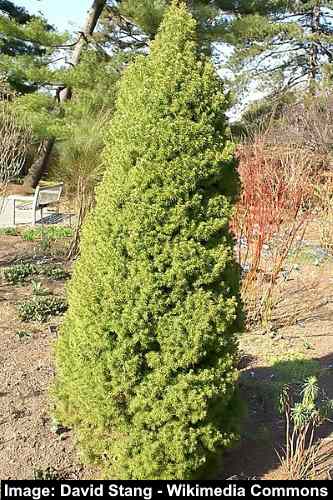
Dwarf Alberta spruce is a popular evergreen conifer tree well-suited for small, shaded gardens. The compact evergreen tree has a pyramidal shape and dense foliage of short, fragrant, light green needles. It’s a slow-growing cone-shaped conifer that reaches 4 feet (1.2 m) tall after ten years.
The low-maintenance, easy-care dwarf Alberta spruce retains its conical shape without pruning. It is drought-tolerant and thrives in cool summers and afternoon shade. Its compact size and attractive appearance make it popular for foundation planting or creating an impenetrable privacy screen. It rarely flowers or produces cones.
- USDA Growing Zone: 3 to 6
- Mature Tree Size: 3 to 13 ft. (0.9 – 4 m) tall and 1 to 10 ft. (0.3 – 3 m) wide
- Sunlight: Full sun to partial shade
Black Hills Spruce (Picea glauca densata)

Black Hills spruce is a medium-sized ornamental conifer suitable for shady spots. The evergreen tree has dense foliage and a compact, pyramidal shape, making it popular for landscaping. It’s a slow-growing coniferous tree that eventually matures at 60 ft. (18 m).
Black Hills spruce trees adapt well to cold weather and require little to no pruning. Landscape uses include a specimen tree, windbreak, or privacy screen.
- USDA Growing Zone: 2 to 6
- Mature Tree Size: Slow growing, 30 to 60 ft. (9 – 18 m) tall and 25 ft. (7.6 m) wide
- Sunlight: Full sun or partial shade
Red Spruce (Picea rubens)
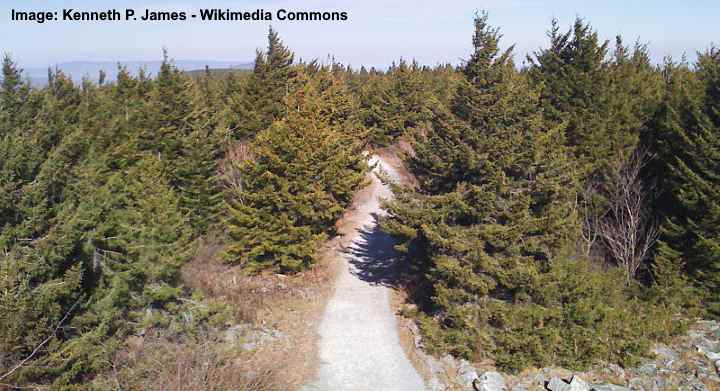
Red spruce is one of the few coniferous evergreen trees that performs well in full shade. Identifying features of the conifer are its conical crown, cylindrical, cinnamon-brown cones, and bright, yellow-green needle leaves. Like most spruces, this variety is a slow-growing tree that thrives in climates with cold winters and cool summers.
- USDA Growing Zone: 2 to 5
- Mature Tree Size: 70 to 100 ft. (21 – 30 m) tall and up to 40 ft. (12 m) wide
- Sunlight: Full sun, partial shade, full shade
American Arborvitae ‘Smaragd’ (Thuja occidentalis ‘Smaragd’)

American arborvitae ‘Smaragd’ is a popular evergreen conifer that grows well in partial shade. The landscaping plant is known for its narrow, pyramidal shape, soft, emerald-green scale-like sprays, and aromatic reddish-brown bark. Not growing taller than 15 ft. (4.5 m), the easy-grow conifer retains its beautiful colors throughout the year.
The dense foliage of the American arborvitae ‘Smaragd’ makes it a valuable landscaping shade tree. It keeps its cone-like shape without pruning. Landscaping ideas for the tree include hedges, privacy screens, specimen plants, or windbreaks. Despite being a sun-loving conifer, it performs well in shady spots.
- USDA Growing Zone: 2 to 7
- Mature Tree Size: 12 to 14 ft. (3.6 – 4.3 m) tall and 3 to 4 ft. (0.9 – 1.2 m) wide
- Sunlight: Full sun to partial shade
Giant Arborvitae (Thuja plicata)
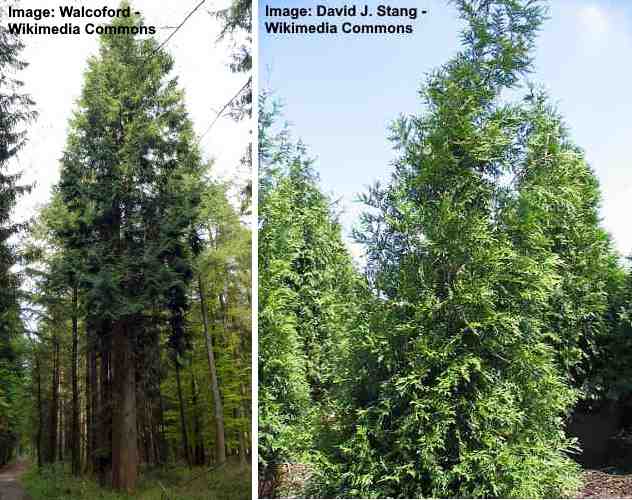
Giant arborvitae is a very tall conifer tree (left) but dwarf cultivars are available too such as Thuja plicata ‘Green Giant’ (right)
Giant arborvitae is a fast-growing evergreen tree that tolerates partial shade. The hardy conifer is characterized by its lush, dense green foliage, small upright cones, and conical shape. This conifer variety grows up to 60 ft. (18 m) tall, making it one of the largest arborvitae varieties. It also retains its shape without pruning.
Also called the green giant, the large arborvitae is adaptable to various soil types, especially moist, well-drained ones. It’s a hybrid conifer with pest-resistance traits that adapts well to various climates. The Thuja’s fast growth and minimal care requirements make it popular in backyard landscaping. Uses for the evergreen tree include natural barriers, hedges, windbreaks, and privacy screening.
- USDA Growing Zone: 5 to 7
- Mature Tree Size: 40 to 60 ft. (12 – 18 m) tall and 18 ft. (5.5 m) wide
- Sunlight: Full sun to partial shade
Golden Irish Yew (Taxus baccata ‘Fastigiata aurea’)

The golden Irish yew is an evergreen that tolerates full shade without compromising its excellent growth. The columnar evergreen conifer tree has dense foliage of golden-yellow to lime-green needles and conspicuous red berry-like cones. Its pencil-like habit creates an eye-catching vertical accent in landscapes.
This golden Irish yew has slow to moderate growth. The beautiful conifer doesn’t grow taller than 10 feet (3 m) and has a narrow habit. Thriving in full to partial shade, the yew is a stunning specimen conifer. Other uses in the landscape include growing at the corner of a house or creating an evergreen hedgerow.
- USDA Growing Zone: 7 and 8
- Mature Tree Size: 4 to 10 ft. (1.2 – 3 m) tall and 2 to 3 ft. (0.6 – 0.9 m) wide
- Sunlight: Full sun, partial shade, full shade
Anglo-Japanese Yew (Taxus x media ‘Hicksii’)
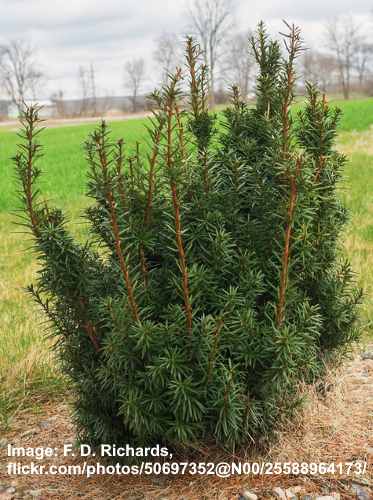
Anglo-Japanese yew is a versatile evergreen coniferous tree or shrub that performs exceptionally well in partial or deep shade. This yew tree is identified by its upright, narrowly columnar form, dark green, needle-like leaves, and coral-red fleshy cones resembling berries. The slow-growing conifer grows up to 20 ft. (6 m) tall.
The Anglo-Japanese yew is a low-maintenance tree requiring minimal pruning. It tolerates a wide range of conditions, including urban pollution, drought, and heavy shade. You can plant this conifer as a privacy screen, hedge, or foundation planting. Additionally, it is easy to prune into various topiary shapes.
- USDA Growing Zone: 4 to 7
- Mature Tree Size: 12 to 20 ft. (3.6 – 6 m) tall and 8 to 12 ft. (2.4 – 3.6 m) wide
- Sunlight: Full sun, partial shade, heavy shade
American Yew (Taxus canadensis)
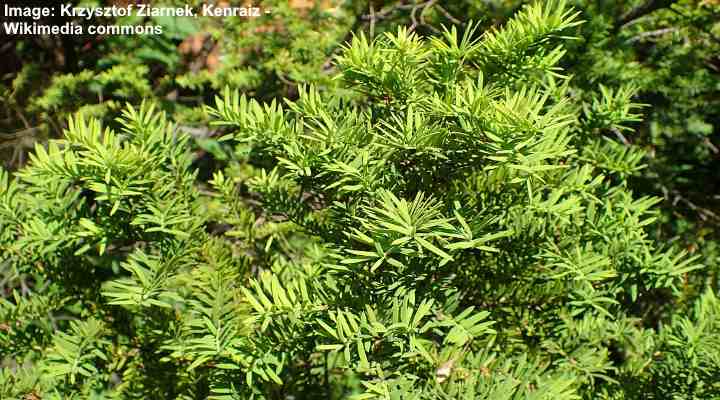
Like most yew varieties, the American native yew is a shade-loving evergreen conifer. Its identifying features include flat, narrow, dark green needle-like leaves, bright red seed-bearing cones, and reddish-brown winter colors. This sprawling evergreen shrub-like dwarf tree doesn’t grow taller than 6 ft. (1.8 m), which is ideal for landscaping compact yards.
The dark green foliage of the American yew grows dense, giving the plant an attractive, compact appearance. Thriving in the shade and well-drained soils, it grows well as a small hedge, foundation planting, or privacy screen for a backyard. Its tolerance for moist soils also means it performs well near streams and ponds.
- USDA Growing Zone: 3 to 7
- Mature Tree Size: 3 to 6 ft. (0.9 – 1.8 m) tall and 6 to 8 ft. (1.8 – 2.4 m) wide
- Sunlight: Full shade, partial shade, deep shade
Japanese Yew (Taxus cuspidata)

Cloud pruning of Japanese yew (Taxus cuspidata) tree
Japanese yew is a shade-tolerant evergreen conifer with rapid growth. Its deep green, glossy foliage and bright red berry-like, fleshy cones (arils) add texture and beauty to garden landscapes. The compact conifer has a vase shape, and its bark is dark brown and scaly. The mid-sized conifers grow up to 25 ft. (7.6 m) tall.
Japanese yew survives in less than two hours of direct sunlight daily. Despite its shade tolerance, it grows fast in various types of soils. It also tolerates urban conditions, cold, and drought. This versatile evergreen shade tree performs well as a hedge, privacy barrier, foundation planting, and accent plant.
- USDA Growing Zone: 4 to 7
- Mature Tree Size: 10 to 25 ft. (3 – 7.6 m) tall
- Sunlight: Full sun to full shade
Pacific Yew (Taxus brevifolia)

Native to the Pacific Northwest of North America, this yew variety is sun and shade-tolerant. Characteristics of the evergreen plant include its dark green, flat, needle-like leaves, fleshy red arils, and thin, scaly red bark. Its leaves measure up to 1.2” (3 cm) long, growing spirally on stems. The small evergreen conifer grows exceedingly slowly.
Pacific yew trees thrive in shady understory environments. Their slow growth makes them ideal landscaping plants for residential front and backyards. The dense and bushy ornamental trees are useful in yards as privacy screens, windbreaks, shade, and erosion control. Its coral-red fleshy cones also attract birds and wildlife, boosting biodiversity in your garden.
- USDA Growing Zone: 4 to 7
- Mature Tree Size: 33 to 50 ft. (10 – 15 m) tall
- Sunlight: Partial shade to full shade
Eastern Hemlock (Tsuga canadensis)
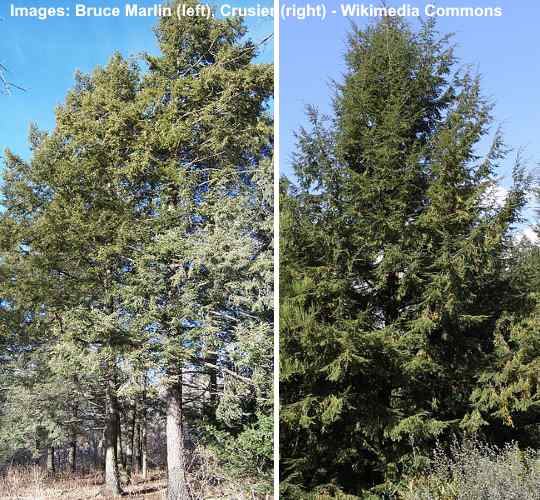
The Eastern hemlock is a shade-tolerant evergreen coniferous tree with vigorous growth. Native to Eastern North America, the conifer is broadly conical, featuring feathery foliage and dark green needles. The tree’s arching branches, pendulous tips, and dangling egg-shaped cones add to its graceful appearance. Mature trees have purplish-gray bark.
Eastern hemlocks perform well in partial shade or full sun. However, they can also tolerate deep shade. Growing up to 70 ft. (21 m) tall, this hemlock tree species is low maintenance and grows easily in acidic, humus-rich soils with excellent drainage. They have a growth rate of 12” to 24” (30 – 60 cm) per year.
- USDA Growing Zone: 3 to 7
- Mature Tree Size: 40 to 70 ft. (12 – 21 m) tall and 25 to 35 ft. (7.6 – 10.7 m) wide
- Sunlight: Full sun or partial shade is best, but they also grow in full shade
Western Hemlock (Tsuga heterophylla)
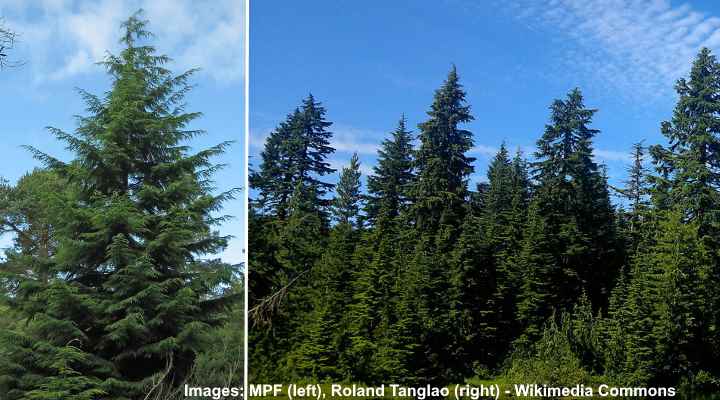
Western hemlock is an exceptionally shade-tolerant evergreen tree native to the Pacific Northwest. The tall conifer has a pyramidal shape and has soft, flat needles with serrated margins. In coniferous forests, it is identified by its conical shape and pendulous branchlet tips. Western hemlocks also produce small, light brown cylindrical cones.
Western hemlocks are huge conifer trees growing up to 230 feet (70 m) tall, making them one of the largest conifers in North America. The tree’s size means they are mostly suited to large woodlands, where their timber is used for paper production. However, they are popular as privacy screens, windbreaks, or focal points in large gardens.
- USDA Growing Zone: 5 to 8
- Mature Tree Size: 165 to 230 ft. (50 – 70 m) tall
- Sunlight: Partial shade or full sun
Serbian Spruce (Picea omorika)

Serbian spruce is an attractive evergreen tree that tolerates light to partial shade. The ornamental conifer is prized for its slender shape and attractive blue-green needles. The flat, dark green, sharply pointed needles have two white lines on the silvery underside. The tree has a pyramidal form and grows up to 60 feet (18 m).
Serbian spruce is a cold-hardy evergreen that adapts to various soil conditions. Its arching, conical growth and dark foliage make it an attractive addition to garden landscapes. Popular uses for Serbian spruce include an ornamental accent tree, specimen plant, or mass planting to create a privacy hedge.
- USDA Growing Zone: 4 to 7
- Mature Tree Size: Up to 60 ft. (18 m) tall
- Sunlight: Partial shade
Concolor Fir (Abies concolor)

Concolor fir is a large evergreen conifer tree with some shade tolerance. Identifying features of the fir tree are its thick gray bark, flattened, needle-like leaves 3.1” (7.8 cm) long, and cylindrical, brown cones 4.75” (12 cm) long. Although most fir trees are sun-loving conifers, the concolor fir is one of the more shade-tolerant species.
Also called white fir, concolor fir trees have an attractive pyramidal shape as they mature. The Abies concolor ‘Compacta’ is a suitable white fir for residential landscapes. It only grows 8 ft. (2.4 m) tall and has tremendous ornamental value. Like the larger specimens, the dwarf fir trees are drought-tolerant and adaptable to various soil conditions.
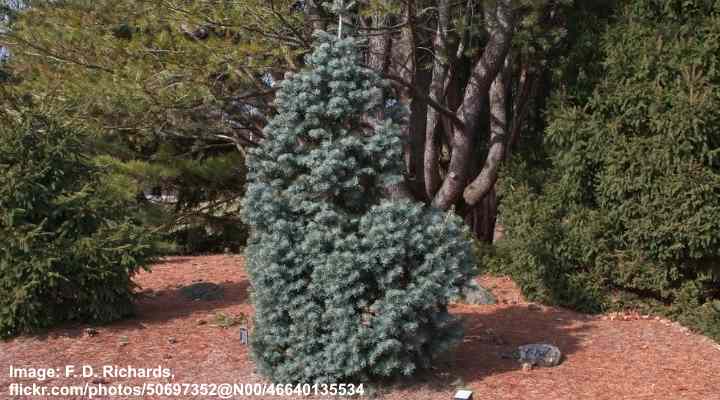
Dwarf white fir (Abies concolor ‘Compacta’)
- USDA Growing Zone: 4 to 7
- Mature Tree Size: 82 to 200 ft. (25 – 60 m) tall, but dwarf varieties are much smaller
- Sunlight: Full sun to partial shade
Pacific Silver Fir (Abies amabilis)

Pacific silver fir is a majestic evergreen tree that thrives in shady environments. It is characterized by its tall, symmetrical shape and soft, blue-green, flattened needles arranged spirally. The tall conifer also has dark purple, barrel-like seed cones 6.75” (17 cm) long that stand erect on horizontal branches.
Growing up to 150 feet (45 m) tall, Pacific silver fir is a towering presence in coniferous forests. If you want to grow a Pacific silver fir in your garden, look for some of the dwarf shrub varieties. The Abies amabilis ‘Compacta’ or ‘Spreading Star’ are low-growing landscaping conifers that don’t grow taller than 3 feet (0.9 m) tall.

‘Spreading Star’ Pacific silver fir
- USDA Growing Zone: 6 to 8
- Mature Tree Size: Up to 100 to 150 ft. (30 – 45 m) tall
- Sunlight: Full sun, partial shade, or full shade
Eastern White Pine (Pinus strobus)

Eastern white pine is a large, fast-growing evergreen tree that can tolerate up to 80 percent shade. The native pine tree has soft, bluish-green needles measuring 5” (13 cm) long. The shade-tolerant conifer has a straight trunk, open pyramidal to oval crown, and cylindrical brown cones dangling from branches.
Eastern white pine trees grow up to 80 feet (24 m) tall, typically too large for residential landscapes. Some white pine dwarf cultivars that tolerate light shade include Pinus strobus ‘Pendula’ (10 ft. or 3 m tall), ‘Louie’ (20 ft. or 6 m tall), and ‘Nana’—a dwarf, evergreen shrub growing up to 7 ft. (2.1 m) tall.

Pinus strobus ‘Nana’
- USDA Growing Zone: 3 to 8
- Mature Tree Size: 50 to 80 ft. (15 – 24 m) tall
- Sunlight: Full sun, dappled sunlight, or partial shade
Lawson Cypress (Chamaecyparis lawsoniana)

Lawson cypress is a versatile shade-tolerant evergreen tree native to northwestern North America. Also called Port Orford cedar, the conifer’s identifying features are its feathery, blue-green flat sprays, globose seed cones, and silver-brown bark with vertical ridges. The scale-like foliage emits a pleasant, lemon-like fragrance when crushed.
Growing up to 200 feet (61 m) tall, the Lawson cypress is an impressive tree in western forests. However, smaller false cypress, shade-tolerant cultivars are more suited to residential landscapes. These evergreens are ideal for privacy screens, windbreaks, or specimen trees in shady spots in your backyard.

Chamaecyparis lawsoniana ‘Minima Aurea’ grows up to 4 ft. (1.2 m) tall and 2 ft. (0.6 m) wide.
- USDA Growing Zone: 5 to 8
- Mature Tree Size: Up to 200 ft. (61 m) tall; however, smaller dwarf Lawson cypress trees measure 3 to 20 ft. (0.9 – 6 m)
- Sunlight: Full sun to partial shade
Japanese False Cypress (Chamaecyparis pisifera)

Japanese false cypress is an attractive evergreen conifer tree that tolerates shade. The cultivated species don’t grow taller than 30 ft (9 m) and are commonly used in landscaping. The tree has a pyramidal shape and pale green to bluish-green foliage. The leaves are scale-like and arranged in flattened sprays.
Japanese false cypress trees require minimal pruning to maintain their attractive shape. The conifers are resistant to most pests and diseases and are tolerant of drought and heat. This low-maintenance, shade-tolerant evergreen tree is popular as a privacy screen, hedge, foundation planting, or accent tree in shaded gardens.
- USDA Growing Zone: 4 to 8
- Mature Tree Size: 20 to 30 ft. (6 – 9 m) tall; however, specimens in forests can grow up to 70 ft. (21 m)
- Sunlight: Partial shade to full sun
Related articles:
